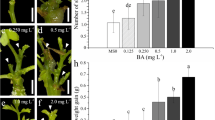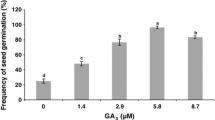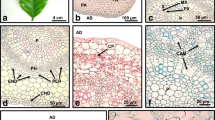Abstract
Jatropha curcas, a non-domesticated energy plant, has emerged as a source of biodiesel as it does not compete with the edible oil supplies. Realizing its importance, in vitro regeneration methods have been established to meet the demand of large scale supply of superior clones. However, no precise histological analysis has been conducted to document the in vitro morphogenesis in J. curcas. Here, we present a detailed histological description of the initiation of growth and morphogenesis from callus induced from immature cotyledon and embryonal axis of J. curcas. Microscopic observations revealed that the cells of sub-epidermis in immature cotyledon became meristematic and divided extensively to result in the formation of meristemoids within 3–4 weeks of culture. The meristemoid cells are compact, small, and exhibited densely stained cytoplasm compared to the loosely packed large non-meristematic cells. Presence of meristemoids in different developmental stages above the cambial zone, and the absence of vascular connection to the cotyledon explant led us to conclude that the origin of the meristemoids was adventitious in nature and regeneration is through organogenesis of morphogenic callus. On the other hand, callus derived from immature embryonal axis followed two types of regeneration—one type of shoot regeneration was via organogenesis while the second type was through multiplication of the pre-existing meristems. It was noticed that under similar experimental conditions, the process of organogenesis varied from explant to explant. The present study contributes to adequate knowledge and understanding the process of in vitro shoot morphogenesis in J. curcas.




Similar content being viewed by others
References
Achten WMJ, Maes WH, Aerts R, Verchot L, Trabucco A, Mathijs E, Singh VP, Muys B (2010) Jatropha: from global hype to local opportunity. J Arid Environ 74:164–165
Deore AC, Johnson TS (2008) High-frequency plant regeneration from leaf-disc cultures of Jatropha curcas L.: an important biodiesel plant. Plant Biotechnol Rep 2:7–11
Esau K (1977) Anatomy of seed plants. John Wiley and Sons, New York, pp 271–295
Eswaran N, Parameswaran S, Sathram B, Anantharaman B, Raja Krishna Kumar G, Tangirala SJ (2010) Yeast functional screen to identify genetic determinants capable of conferring abiotic stress tolerance in Jatropha curcas. BMC Biotechnol 10:23
Ghosh A, Chaudhary DR, Reddy MP, Rao SN, Chikara J, Pandya JB, Patolia JS, Gandhi MR, Adimurthy S, Vaghela N, Mishra S, Rathod MR, Prakash AR, Shethia BD, Upadhyay SC, Balakrishna V, Prakash CR, Ghosh PK (2007) Prospects for Jatropha methyl ester (biodiesel) in India. Int J Environ Stud 64:659–674
Hu JB, Liu J, Yan HB, Xie CH (2005) Histological observations of morphogenesis in petiole derived callus of Amorphophallus rivieri Durieu in vitro. Plant Cell Rep 24:642–648
Kalimuthu K, Paulsamy S, Senthilkumar R, Sathya M (2007) In vitro propagation of the biodiesel plant Jatropha curcas L. Plant Tissue Cult Biotech 17:137–147
Khurana-Kaul V, Kachhwaha S, Kothari SL (2010) Direct shoot regeneration from leaf explants of Jatropha curcas in response to thidiazuron and high copper contents in the medium. Biol Plant 54:369–372
Kothari SL, Varshney A (1998) Morphogenesis in long term maintained immature embryo derived callus of wheat (Triticum aestivum L.)—histological evidence for both somatic embryogenesis and organogenesis. Plant Biochem Biotechnol 7:93–98
Kulchetscki L, Harry IS, Yeung EC, Thorpe TA (1995) In vitro regeneration of Pacific silver fir (Abies amabilis) plantlets and histological analysis of shoot formation. Tree Physiol 15:727–738
Kumar A, Sharma S (2008) An evaluation of multipurpose oil seed crop for industrial uses (Jatropha curcas L.). A review. Ind Crops Prod 28:1–10
Murashige T, Skoog F (1962) A revised medium for rapid growth and bioassays with tobacco tissue culture. Physiol Plant 15:473–497
Oka S, Saito N, Kawaguchi H (1995) Histological observations on initiation and morphogenesis in immature and mature embryo derived callus of barley (Hordeum vulgare L.). Ann Bot 76:487–492
Rao GR, Korwar GR, Shanker AK, Ramakrishna YS (2008) Genetic variations, variability and diversity in seed characters, growth reproductive phenology and yield in Jatropha curcas (L.) accessions. Trees 22:697–709
Sancak C, Mirici S, Ozcan S (2000) High frequency shoot regeneration from immature embryo explants of Hungarian vetch. Plant Cell Tissue Org Cult 61:231–235
Saravitz CH, Blazich FA, Amerson HV (1993) Histology of in vitro adventitious bud development on cotyledons and hypocotyls of Fraser fir. J Am Soc Hortic Sci 118:163–167
Sujatha M, Sivaraj N, Prasad MS (2000) Biochemical and histological changes during in vitro organogenesis in Jatropha integerrima. Biol Plant 43:167–171
Sujatha M, Reddy TP, Mahasi MJ (2008) Role of biotechnological interventions in the improvement of castor (Ricinus communis L.) and Jatropha curcas L. Biotech Adv 26:424–435
Varshney A, Johnson TS (2010) Efficient plant regeneration from immature embryo cultures of Jatropha curcas, a biodiesel plant. Plant Biotechnol Rep 4:139–148
Yeung EC (1999) The use of histology in the study of plant tissue culture systems. Some practical comments. In Vitro Cell Dev Biol Plant 35:137–143
Acknowledgments
The authors thank J.V. Narasimham, Dr. S. Harinarayana Rao and V. S. Vasania for their help in plant material, histological procedure and photography, respectively. We are also grateful to Reliance Life Sciences for giving us the opportunity to carry out this work. Help of Dr. Md. Umer Sherif, Director, Botanical Survey of India, Yercaud, India whose help in identifying various morphogenic stages is acknowledged.
Author information
Authors and Affiliations
Corresponding author
Additional information
Communicated by E. Beck.
Rights and permissions
About this article
Cite this article
Varshney, A., Sangapillai, R., Patil, M.S. et al. Histological evidence of morphogenesis from various explants of Jatropha curcas L.. Trees 25, 689–694 (2011). https://doi.org/10.1007/s00468-011-0546-x
Received:
Revised:
Accepted:
Published:
Issue Date:
DOI: https://doi.org/10.1007/s00468-011-0546-x




